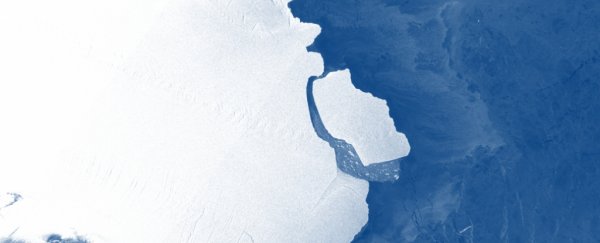For nearly 20 years, researchers have closely watched a "loose tooth" of ice dangle from the edge of the Antarctic ice sheet, waiting for it to detach.
It turns out, we were keeping our eyes on the wrong part. According to the Australian Antarctic Division, a neighbouring slab of ice along the same rift system has just broken off the Amery ice shelf. And it's even bigger than its still-wobbling neighbour.
Known as D28, the giant iceberg is roughly the size of urban Sydney, Australia, covering 1,636 square kilometres (632 square miles) and reaching about 210 metres deep (689 feet). Altogether, it amounts to some 315 billion tonnes of ice - the largest iceberg produced by the Amery ice shelf in more than half a century.
"It is the molar compared to a baby tooth," researcher Helen Fricker from the Scripps Institution of Oceanography told BBC News.
While that might sound alarming given the current state of our planet, Fricker says this is a natural inevitability known as calving - the ice shelf is sloughing off its edges to make room for new flows of ice and snow.
It's an important way for ice sheets around the world to balance their masses, but each one experiences a different rate of calving that can vary across seasons and take decades or longer to complete.
All these variables make it challenging to predict when an iceberg will calve, and in this case, researchers were off on both the timeline and the location.
"We first noticed a rift at the front of the ice shelf in the early 2000s and predicted a large iceberg would break off between 2010 and 2015," says Fricker.
"I am excited to see this calving event after all these years. We knew it would happen eventually, but just to keep us all on our toes, it is not exactly where we expected it to be."
 (NASA)
(NASA)
The last time the Amery ice shelf produced an iceberg like this, it was 1963. At 9,000 square kilometres, the resulting iceberg back then was even bigger than what we are seeing today.
Normally, this particular ice shelf is thought to experience one major calving event every six or seven decades, and the two we've seen so far certainly fit that cycle.
As a result, Fricker and her colleagues do not think this event is linked to climate change; but that isn't the case with all calving events.
In Western Antarctica, for example, Pine Glacier's calving rate has begun to speed up and spread deeper, shedding massive icebergs in 2013, 2015, 2017, and 2018, instead of every six years as is natural for this glacier.
Sue Cook from the Institute of Marine and Antarctic Studies (IMAS) told the Australian Broadcasting Corporation that she definitely expects iceberg calving to increase in the future due to climate change.
"There are a number of different processes that'll happen," she explained.
"As waters around Antarctica warm up, they'll start thinning the ice shelves and making them more vulnerable to breaking up."
